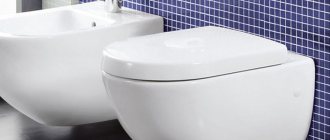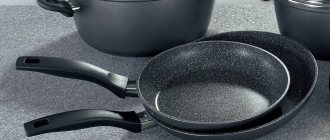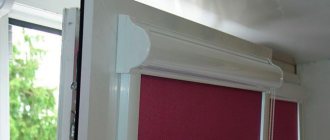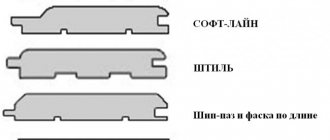Main types of toilets
Toilets can be divided into three main types:
- suspension;
- attached;
- floor.
These types are designed for installation in rooms of different sizes, and are distinguished not only by reliability, but also by price.
Suspension
In small rooms, as a rule, wall-hung toilets are installed. These toilets are good because the flush tank and pipelines are mounted separately from the toilet. The suspended type is noticeably shorter than the floor-mounted one, but requires more careful installation. The thing is that the pipelines and the drain tank are hidden in the wall, and these elements must be assembled as reliably as possible. A wall-hung toilet looks much more aesthetically pleasing than a floor-mounted or wall-mounted one. A wall-hung toilet is also much easier to keep clean. Many people think that a wall-hung toilet is an unreliable design, but this is far from the case. The wall-hung toilet can withstand a weight of 400 kg, and in terms of reliability, everything is in order. The model can be safely chosen for any bathroom. Installing a wall-hung toilet is much more expensive than installing a floor-mounted plumbing fixture.
Floor
The most common type is floor-mounted toilets. These devices are optimal not only in terms of design, but also in terms of price. Floor standing toilets are very easy to install and maintain. These plumbing devices are also divided into several types:
- vertical;
- oblique;
- horizontal.
These toilets differ from each other in the design of the drain outlet. Vertical toilets are usually used in private housing construction, which are equipped with individual sewerage. In multi-storey buildings, toilets with horizontal outlet are used. Toilets with an oblique outlet are designed for older houses. To choose the right toilet, you first need to find out for sure what type of drain outlet you have.
Pristavnoy
Attached toilets also significantly save space, and are something between a floor-mounted and wall-hung toilet. The best choice for your home. The connections for the attached toilet are hidden in the wall, and the flush cistern is located separately from the toilet. An attached-type plumbing product is not hung on the wall, but is attached to the floor. Installation of an attached toilet requires special attention from a master plumber, since troubleshooting problems in the pipelines or in the cistern may entail the dismantling of decorative panels, which is extremely undesirable. The cost of these plumbing devices is noticeably higher than that of their floor-standing counterparts.
Flush
In order not to clean the structure with your own hands, the designers came up with an entire drainage system designed to remove waste products and clean the surface. It should be noted that there are several variants of different designs of this technical solution that differ from each other.
Two main types of water drainage
Direct drain
- This flushing system is considered the simplest, and its price is minimal. It was developed very first and is still used today.
Some designs provide direct drainage from different points
- It is worth noting that this water supply option is excellent for structures without shelves. It is also often used for products with a slight slope. However, recently manufacturers have been leaning towards other models.
- The fact is that some toilet designs also spray water during such a flush, especially if there is an obstacle in its path in the form of waste products.
Advice! You should choose such systems only if you want to save money. More expensive models are equipped with other water supply options that are much more efficient.
With proper swirling, the water washes out even the most inaccessible places
Eddy drain
It’s worth saying right away that the instructions for connecting this type of toilet are practically no different from the standard manual. However, the design of the ceramic rim itself presupposes the presence of a certain number of holes and drains, which, when draining water, twist the stream in a spiral, spraying it. This way, moisture washes the entire surface and removes waste more effectively.
Modern masters believe that it is best to purchase a toilet with a horizontal shelf and a flush that fully satisfies all user needs. However, such products usually have a high cost because their manufacturing process is difficult and involves a high level of defects.
Advice! It is very difficult to check such a drain on site. However, popular manufacturers equip sellers with appropriate video materials and other manuals that show the principle of operation.
Choosing the right toilet greatly simplifies the operation process
Selecting a toilet by type of material
All modern toilets are usually made from two materials:
- earthenware;
- porcelain.
Porcelain plumbing fixtures are the most popular, but also the most expensive. Porcelain toilets are the most practical, and they are not as susceptible to contamination as earthenware products. Porcelain has a smoother surface, which is practically free of shells and microcracks. It is the smooth surface that prevents the growth of germs and bacteria. Porcelain products are very easy to maintain and keep clean.
Earthenware toilets are less expensive and require more careful maintenance. The thing is that faience has a more porous structure than porcelain. Therefore, earthenware toilets need to be serviced more often, since all kinds of dirt quickly appear on them. In a store, it is very difficult to determine by eye whether the toilet in front of you is porcelain or earthenware. You can get comprehensive information from a consultant in the store, who can even provide you with a technical passport for the product, which will indicate what material the toilet is made of. It is also easy to determine the material based on the price of the product.
Other materials of manufacture
- Stainless steel is a durable material that is not afraid of moisture, characterized by reliability and durability. Due to these qualities, such plumbing fixtures are often installed in public toilets. However, metal toilets are cold and noisy, so they are not recommended for home use;
- Artificial stone and marble are elite materials that allow you to obtain models with an exquisite and unique design. At the same time, the products are hygienic and durable. In addition, they are economical in water consumption due to the smooth surface from which dirt and bacteria are washed off in a matter of seconds;
- Plastic or acrylic is used to make lightweight and short-lived toilets. They are installed in a short time and without problems. This is a suitable solution for a summer house or for temporary and auxiliary premises.
Selection according to bowl shape
When choosing a toilet for your home, you should pay attention to the type of structure of the bowl. The list of these types includes:
- bowl with “shelf”;
- bowl with vertical drain (funnel-shaped);
- bowl with offset drain.
A bowl with a “shelf” has come to us since Soviet times, but such sanitary products can still be found in stores. The advantage of such a toilet is that it practically does not splash when flushing.
The funnel-shaped bowl is by far the most popular. These toilets are very easy to maintain and very effective in terms of hygiene. The drain neck of a toilet with a funnel-shaped bowl is located in the center, which ensures an unobstructed and powerful flush. The only drawback of this bowl structure is that when draining, a large amount of splashes is formed.
Also in demand are plumbing products that have an offset (oblique) release form. It is this bowl geometry that toilets with an anti-splash system are equipped with. This system allows you to minimize the formation of splashes - due to the shape of the bowl, and due to a special small protrusion that rationally distributes the flow of water when draining. The absence of splashes is also explained by the fact that the water level in toilets with an anti-splash system is at a sufficient distance from the body.
Flush type
Flushing in modern toilets also varies. You should also pay attention to it when choosing. Flushing can be done:
- horizontal way;
- direct vertical method;
- in a circular vertical manner.
The horizontal flush system is a fairly old system, and the water supply in such a system is carried out from a single point. This type of flush is not very effective because it does not flush the entire toilet bowl. The shortcomings of such a flush have to be corrected with a brush.
Direct vertical flushing is the most modern, and is carried out along the entire perimeter of the bowl. Water washes the entire surface of the bowl with uniform pressure, since the drain holes are evenly distributed - under the rim.
The most advanced type of flush is the vertical circular one. This type is good because when flushed, a water vortex is formed, which more effectively cleans the entire surface of the toilet bowl. This vortex is formed using a clever arrangement of drain holes, which are also located under the rim, along the entire perimeter of the bowl.
Today you can find rimless toilets on sale, which have their pros and cons. This design of plumbing products is good because such toilets are easy to maintain. There is simply nowhere for bacteria and dirt to accumulate on such a toilet, but there is one thing. A rimless toilet has only one point from which water is supplied for flushing. Therefore, the quality of the drain is questionable. Also, a rimless toilet has increased splashing. Such devices require more careful adjustment of the fittings, which will minimize the amount of splashes, and without compromising the quality of the flush itself.
How to choose a splash-free toilet - anti-splash system, how to determine its presence when buying a toilet
The system is designed to compensate for splashes during toilet operation
It should be noted that the labeling of many toilets indicates the presence of such an option, but in practice you should not trust the advertising tricks of manufacturers. You can make the right choice yourself by studying how the system works and what it consists of. Some consultants in plumbing stores try to tell the client that the anti-splash is an inclined wall on the inner surface of the device, along which water slowly flows, thereby not forming splashes
This explanation cannot be real and suggests that either the seller is illiterate or is trying to sell a product that does not have an anti-splash system
Some consultants in plumbing stores try to tell the client that the anti-splash is an inclined wall on the inner surface of the device, along which water slowly flows, thereby not forming splashes. This explanation cannot be real and suggests that either the seller is illiterate or is trying to sell a product that does not have an anti-splash system.
An anti-splash in a toilet is a drain hole made in a special geometric shape, which is narrowed as much as possible and recessed into the lower part of the toilet. In addition, the hole is shifted relative to the axis of symmetry to one of the sides, and the level of the water column in the hole is significantly reduced. In addition, a circular rim is designed along its contour, which performs additional compensation functions.
Taking a closer look and correcting for optical distortions caused by water in the photo, you can determine that the drain hole is very narrow and the water level is unusually low.
How to calculate the height of the water column in the drain hole while in the store
When considering a purchase option, it is necessary to determine the water level in the unconnected product, which, as you know, should be the lowest. This skill will be useful for choosing a high-quality toilet with an anti-splash system.
From the physics course we know that according to the law of communicating vessels, the level in the toilet will be determined by the lower point of the outlet, located on the back side.
To determine the water level, it is enough to mentally draw a line parallel to the floor through the bottom point of the toilet outlet channel and, based on the level of this line, determine the column of water in the drain hole.
The anti-splash criteria for any shape, size, or color of the toilet are the same. Taking them as a basis, you can be sure that the chosen toilet will meet your desires and bring only pleasure.
Types of covers
Toilet lids are an accompanying device, but the convenience of staying in difficult times depends on their choice. Lids can be divided into two types:
- universal;
- model.
Universal lids fit all types of modern toilets. Model covers are developed specifically for a specific type of plumbing product. Toilet covers not only perform hygienic functions, but also make using the toilet more convenient. The toilet lid consists of two parts - the lid and the seat. These parts carry different functional loads. The cover itself prevents the spread of moisture and foreign odors, and the seat is designed to provide maximum comfort. Toilet lids can also be divided into several types to suit different types of users. The list of these types includes:
- standard covers;
- baby caps;
- special covers.
Standard toilet lids can be used by people of all ages. Special covers are made for people with disabilities. Also, special toilet lids can be adapted for camping conditions. Children's toilet lids are reduced in size because they are designed for children. Baby lids come not only in small sizes, but also in folding sizes.
Toilet lids can be made from different materials. The most common material is plastic, but also used:
- duroplast;
- tree;
- polyvinyl chloride and so on.
Today you can find toilet lids on sale that are equipped with a lot of useful functions. The list of these functions includes:
- water heating;
- automatic flushing;
- microlift
More expensive types of toilet lids are treated with a special antibacterial coating, which prevents the accumulation of dirt.
Deciding on the type of tank and bowl
The toilet bowls themselves may be different. The difficulty of caring for the product and the efficiency of draining depend on their choice.
Funnel-shaped
This bowl is located in the very center of the toilet. Its main advantage is that all waste is immediately washed off, so there is no need for a brush for cleaning. In addition, in such toilets there is practically no splashing when flushing, which makes them especially popular. Another advantage is that they save money on toilet cleaning fluids.
Disc-shaped
In such toilets, the drain hole is shifted forward. In addition, there is a depression in which all the impurities fall, only then they are washed out of the plate-shaped hole under a huge pressure of water. The disadvantage of this design is a huge amount of splashes when flushing. In addition, moisture accumulates on its walls, which leads to the formation of rust.
Kozyrkovaya
The drain hole in the toilet bowls is also shifted slightly forward. But if there is a recess in the dish-shaped bowl, then here it is replaced by a small bend. In addition, such models are distinguished by the fact that they retain splashes when flushed. Experts also say that this is the best option for those who are worried about unpleasant odors in the bathroom.
Another important point is the choice of drain tank. They are:
- connected to the toilet. This design has its advantages: they are easier to install, clean, and repair. And they look more modern.
- Separate. The tank can be mounted closer to the ceiling, above the toilet. This is a typical version of old post-Soviet buildings. Or the model can be supplemented with a tank that is mounted into the wall. This is very convenient, except for one drawback - in the event of a breakdown, it will be difficult to get to the tank.
The volume of tanks varies from 4 to 6 liters. The higher this indicator, the more water will be wasted when flushing. To save on water bills, it is better to buy a toilet equipped with two-button fittings. In this case, only half of the water from the tank is consumed. And although such models are more expensive, purchasing them will be beneficial for those who have meters installed in their house or apartment.
Toilet with installation
Many users do not quite understand what a toilet with installation is. These toilets are a type of wall-hung sanitary fixtures, complete with a wall-mounted structure. It is on this structure that the toilet itself and the flush cistern are installed, and all this is covered with decorative panels. This design is often chosen by clients during major renovations. Toilets with installation can be made from both porcelain and sanitary ware. Basically, these products have a horizontal outlet and are equipped with a dual flush mode. Also, wall-hung toilets with installation are equipped with an advanced lid, which is equipped with a microlift. Depending on the model, the toilet lid may have additional functions.











